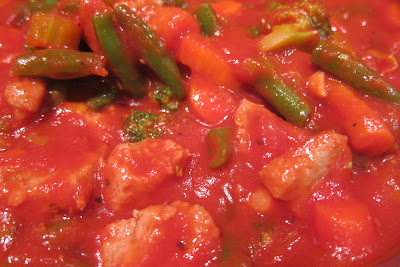Wikipedia files seitan under its common name "wheat gluten," which gives you a clue that it's made out of wheat. It's also called wheat meat, mock duck, gluten meat and just plain gluten. "Gluten" is the protein composite in grains like wheat, barley and rye. It literally means "glue," in Latin, which is why it gives elasticity to dough and helps bread to rise, keep its shape and have a chewy texture. Wiki defines wheat gluten as "a food made from the gluten of wheat. It is made by washing wheat flour dough with water until all the starch dissolves, leaving insoluble gluten as an elastic mass which is then cooked before being eaten. It is an alternative to soybean-based meat substitutes such as tofu." It definitely looks like meat, and you can tell it has undergone some processing or mashing to get into its current form.
Dictionary.com defines it as "a chewy neutral-flavored protein-rich food made of wheat gluten, used as a meat substitute in vegetarian dishes."
Longmans' definition adds a little twist: "Japanese food made from wheat, containing a lot of protein and usually eaten instead of meat."
Bear with me for one more definition; there's a point to this defining moment. Mirrian Webster: "flavored wheat gluten often used as a meat analogue."
Did you notice anything those definitions all have in common? Other than the fact that they are defining the same food? Ok, so I bolded what I wanted to point out. Seitan seems to be "not-something" as opposed to being what it is. ... Following me? Seitan is an alternative, a substitute an analogue, an "instead."
Conversely, tempeh (which I cooked with and blogged about here) is defined for what it is, not for what it isn't.
Wiki: "a traditional soy product originally from Indonesia... made by natural culturing and controlled fermentation process that binds soybeans into a cake form."
Dictionary.com: "a fermented soybean cake."
Longmans: (not in their dictionary)
Mirrian Webster: "an Asian food prepared by fermenting soybeans with a rhizopus."
So I know tempeh was created to be what it is, but was wheat gluten really created by someone who wanted to eat something that reminded them of meat but wasn't meat? This I do not have the answer to.
Anyway.... here's how I actually cooked the seitan:
Wellll, here's everything being cooked before the seitan. Since seitan is already cooked, I had to get all the other components ready first. All four burners were going at the same time! Some whole wheat pasta, tomato sauce with a bunch of spices, steamed cauliflower, and the vegetables that went with the seitan. Once the green beans, carrots and broccoli were almost done cooking, I added the seitan.
Then I poured in the pasta sauce and let it all cook together for a few minutes.
Here it is all served together, with some fresh lemon and ground pepper on top of the cauliflower.It wasn't until a few years ago that I tried adding big chunks of vegetables to my pasta sauce. In the past, I would have only put small chopped up pieces of mushrooms or peppers. It kind of happened by accident one day, when I made pasta with tomato sauce and had steamed broccoli on the side. But I wanted to eat in front of the TV or something with just one dish... so it all got combined, and I liked it! So, there ya go. Pasta sauce with lots of fresh veggies, on top of pasta.
So, the seitan tastes like... wheat. It's meaty, but it's wheaty. When you first bite into as part of the whole dish, it's just chewy and tastes like the rest of the dish. But after a second or two, once the inside flavor comes out (it didn't absorb the vegetable and sauce flavor too deeply), you definitely taste the wheat. I can imagine some people would describe the taste as something like wet cardboard... but I had no problem with it. It is a different flavor. It's something new. I've never eaten something so wet and wheaty and chewy. But I like it. It adds another texture to the overall vegetable-sauce mixture. And, obviously, it's not made from any animal parts and doesn't have the fat and cholesterol of animal meat.
I enjoyed some leftovers a day or two later for lunch out on the deck. Notice the freshly stained decking? ;)
If you're curious, the package of seitan I bought was from Whole Foods Market, found in the refrigerated section near the tempeh and tofu. This 8 oz package was $3.50. And it was the last one they had in stock at the end of the day, so buying "cubed" was my only option. It's also sold in strips and all ground up (like ground beef). Next time I make something like this, I'd probably use the ground up version. It would also work perfectly in chili. Future grocery store trip to Whole Foods - hopefully coming up soon!










3 comments:
I have actually come across a few recipes that call for seitan and I have not been able to find it in stores. Now I'm even more determined to find it! The meal looks yummy!
I know, it is hard to find! The big stores like Whole Foods and Trader Joe's have it. Maybe some small local "health food" type stores would have it as well? I want to find the crumbles find (like ground beef texture) to make some tacos or to put in chili. :)
Make your own. It's too easy.
Post a Comment